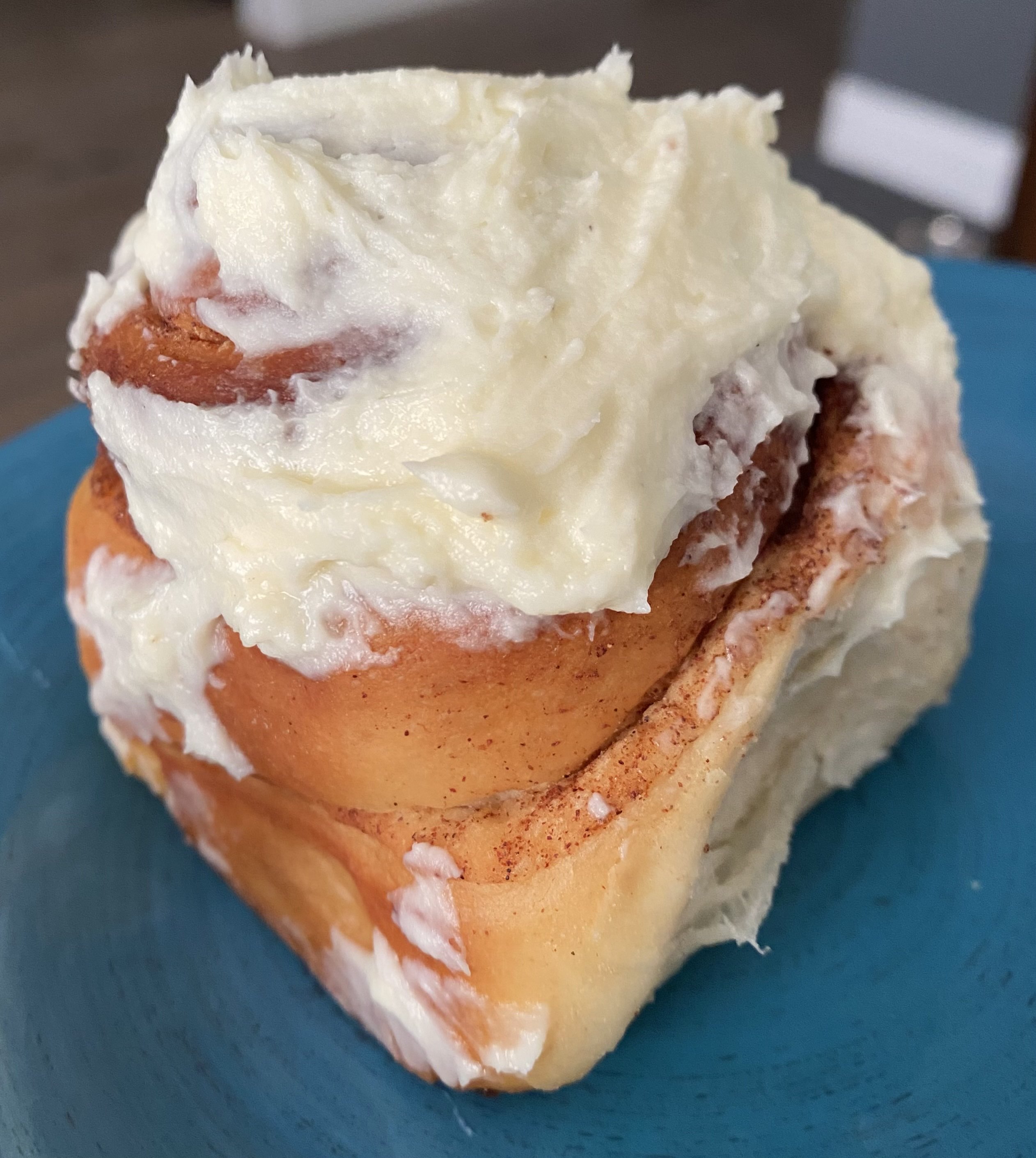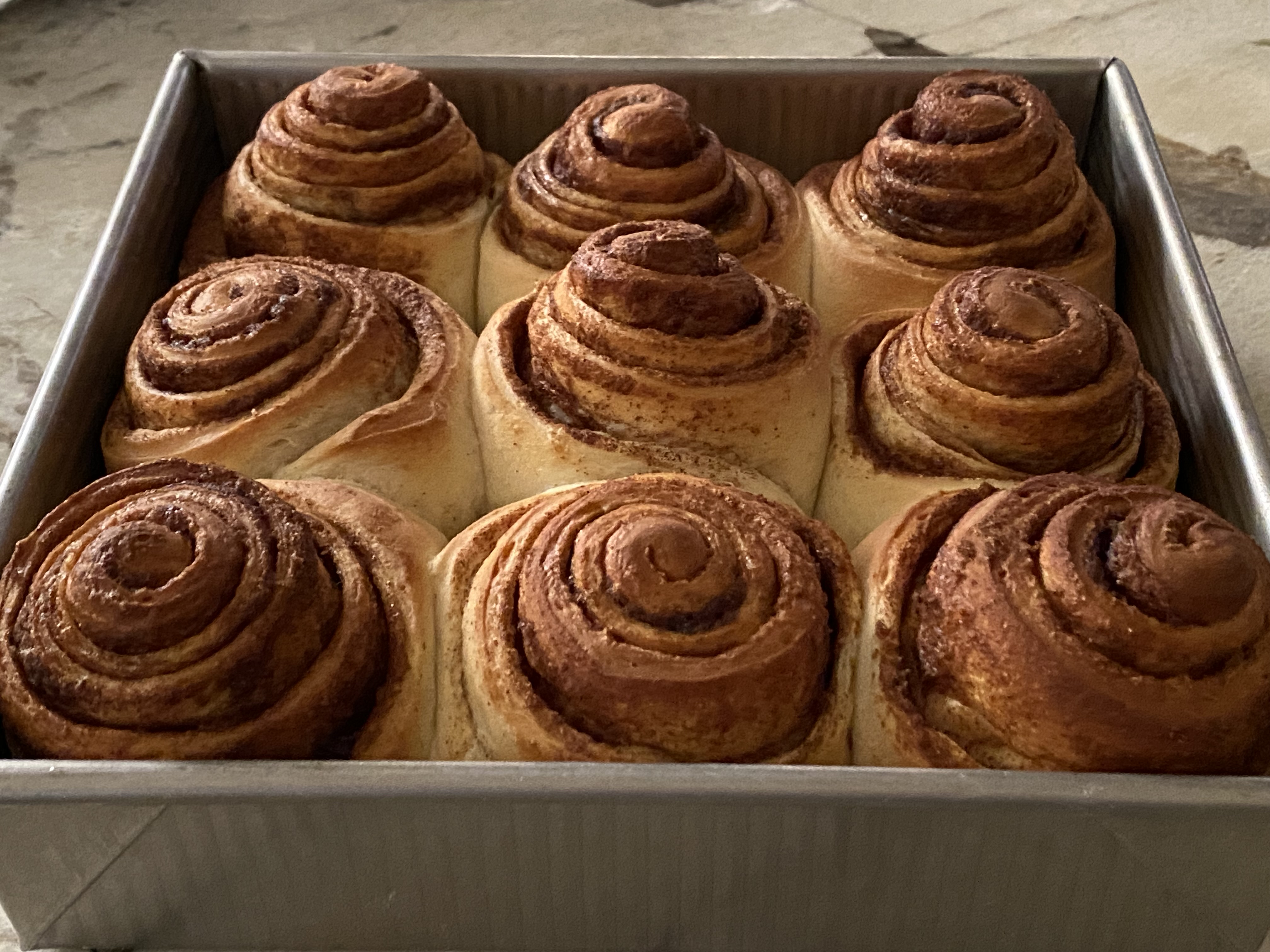Why are you sharing a recipe?
I have a brother who went to culinary school who has also served as executive chef at many restaurants and hotels. Earlier this year we were catching up, and I mentioned that I had been experimenting with incorporating my sourdough starter into a Japanese Milk Bread Recipe. He asked me, "Do you write any of this down?" While I suspect I'm not the first person to do this, he was unaware of anyone who had done this before.
Fast forward to Wednesday morning, the day before Thanksgiving. I made a batch of cinnamon rolls using this dough as a basis. I shared this picture on Khonsu Lab's Discord upon completing them:

A friend asked me this morning for the recipe, so I decided it was time to write it down.
Sourdough Starter
This recipe assumes you have a sourdough starter. If you don't have one, follow a guide to get one started or buy a culture and begin feeding it.
Basic Hypothesis: How to use sourdough in anything
Feeding sourdough is done by adding 50% water and 50% flour. For my starter, I feed it 113g of water and flour each week. When I go to feed it again, I keep 113g of the starter and discard the remaining. This remaining is roughly ~226g.
The hydration content of the starter is roughly 50%. To use sourdough starter in whatever recipe you want, simply reduce the liquid and flour measurements by half of the discard weight.
Using sourdough also affects the final products texture in interesting ways, so you may wish to lower the amount of sourdough starter you use in any given recipe.
Sourdough Milk Bread Recipe

This recipe is a simplified approach to the King Arthur's Japanese Milk Bread recipe with simple changes to incorporate sourdough discard. Weigh your sourdough discard and reduce the milk and flour by half of the weight. Since the discard weight should be roughly ~226g, this means that no extra milk is being added and 187g of flour is added instead of 300g.
The rest of my changes to the recipe are purely process-based to minimize the number of dirty dishes I end up with.
Ingredients
Tangzhong Mixture
- 86g lowfat milk
- If you have whole, use 43g water, 43g milk.
- 14g bread flour
- 47g butter (4 tbsp)
- 1 large egg
Dough
- ~226g Sourdough Starter
- 187g bread flour
- 50g white sugar
- 14g dry milk powder
- 1tsp (6g) salt
- 1tbsp instant yeast
Steps
-
Weigh the tangzhong ingedients into a saucepan. Have the egg and butter nearby. Whisk constantly over as high of heat as you would like, but be careful to turn the heat off as soon as it becomes very thick. It is hard to burn this mixture, but we also don't want to lose too much moisture.
-
Use the residual heat to melt the butter into the tangzhong. This helps cool the mixture down, but also melts our butter in the process. After getting this process started, continue preparing the rest of the dough. This mixture will remain gloopy, don't worry.
-
In your mixing vessel of choice, add the sourdough starter, flour, sugar, salt, and yeast.
-
Add the egg to the warm, but cooled, tangzhong mixture. Whisk until the mixture resembles a slightly lumpy gel. Skipping this step can cause the butter to take longer to incorporate during the kneading process.
-
If you're using a bread maker, run it's dough cycle. If you're using a stand mixer, knead with a dough hook it until the dough pulls way from the sides of the bowl. As the source recipe states: this can take as much as 15 minutes.
You may think it will never happen, but if you've weighed your ingredients, it will suddently start being a little less sticky and start separating from the bowl. Be patient!
-
Give the dough between 60 and 90 minutes for an initial rise
-
Form the dough into whatever shape you are aiming for. It helps to flatten the dough at this stage, and roll it up tightly as part of forming whatever shape you're aiming for.
-
Let the dough rise another 60-90 minutes, aiming for a total of 2-2.5 hours of rise time across both stages.
-
(Optional but worth it) Brush the top of the loaf with a little milk.
-
Bake in a preheated 350F/175C until golden brown. As weird as it may sound, taking the temperature of your loaf/rolls is a good way to verify it's cooked through. Generally any temperature above 185F/85C is done.
Sourdough Milk Bread Cinnamon Rolls

Follow the recipe above until step 7. Or, if you want to include an overnight rise, place the dough after step 6 into the fridge overnight, allowing it ~2 hours to come to closer to room temperature before beginning the steps below.
Additional Incredients
- 47g butter (4tbsp)
- 8tbsp brown sugar
- 2tbsp cinnamon
- A pinch of salt (if using unsalted butter)
Steps
- Mix the brown sugar, cinnamon, and salt thoroughly. The cinnamon helps separate the clumps of brown sugar.
- Using a rolling pin, roll the dough very thin, flouring the surface and rolling pin enough to keep it from sticking.
- Melt the butter, and spread it over the rolled out dough leaving a small border on one side ungreased. This will be the side you roll the dough towards to form the rolls, and this ungreased border will allow you to seal the rolls so that the outer edge doesn't separate during the rise and baking process.
- Generously spread the mixter across the rolls, again trying keep the ungreased border clean.
- Beginning at the side opposite from the ungreased edge, roll the dough onto itself trying to stretch the dough to a uniform width during this process.
- Seal the ungreased edge against the dough. It may help to use a little water to wet the edge.
- Divide the rolls into 9 portions.
- Place the rolls in a greased 9inx9in (~23cmx23cm) baking dish and allow to rise for 60-90 minutes.
- Bake in a preheated 350F/175C oven for ~22-25 minutes until the tops are deeply golden brown and the rolls have reached an internal temperature of at least 185F/85C.
My picture included a basic cream cheese icing using 50% mixture of butter and cream cheese, a splash of vanilla extract, and just enough powdered sugar to reach the right consistency and sweetness we prefer. It's best to let them cool at least 30 minutes before trying to apply cream cheese icing due to how it melts.
